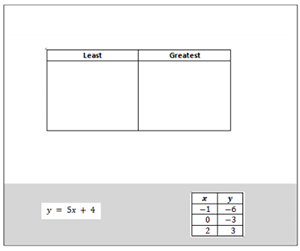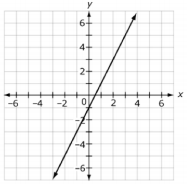Remarks
Examples of Opportunities for In-Depth FocusWork toward meeting this standard repositions previous work with tables and graphs in the new context of input/output rules.
Clusters should not be sorted from Major to Supporting and then taught in that order. To do so would strip the coherence of the mathematical ideas and miss the opportunity to enhance the major work of the grade with the supporting clusters.
- Assessment Limits :
Function notation may not be used. Functions must be linear. - Calculator :
Yes
- Context :
Allowable
- Test Item #: Sample Item 1
- Question:
Drag each function to the box to show the least rate and the greatest rate.

- Difficulty: N/A
- Type: GRID: Graphic Response Item Display
- Test Item #: Sample Item 2
- Question:
Two linear functions are shown.
Function 1:

Function 2:

Create an equation for a third function that has a greater rate of change than one function but a smaller rate of change than the other function.
- Difficulty: N/A
- Type: EE: Equation Editor
Related Courses
Related Access Points
Related Resources
Formative Assessments
Lesson Plans
Original Student Tutorial
Problem-Solving Task
Student Center Activity
Unit/Lesson Sequence
MFAS Formative Assessments
Students are asked to determine and interpret the initial values of two functions represented in different ways (equation and graph), and compare them.
Students are asked to determine the rates of change of two functions presented in different forms (an expression and a table) and determine which is the greater rate of change within a real-world context.
Students are asked to determine the rate of change of two functions presented in different forms (table and graph) and determine which is the greater rate of change within a real-world context.
Students are asked to determine a specific value of two functions given in different forms (a graph and a verbal description) within a real-world context, and compare them.
Original Student Tutorials Mathematics - Grades 6-8
See how sweet it can be to determine the slope of linear functions and compare them in this interactive tutorial. Determine and compare the slopes or the rates of change by using verbal descriptions, tables of values, equations and graphical forms.
Student Resources
Original Student Tutorial
See how sweet it can be to determine the slope of linear functions and compare them in this interactive tutorial. Determine and compare the slopes or the rates of change by using verbal descriptions, tables of values, equations and graphical forms.
Type: Original Student Tutorial
Student Center Activity
Students can practice answering mathematics questions on a variety of topics. With an account, students can save their work and send it to their teacher when complete.
Type: Student Center Activity
Parent Resources
Problem-Solving Task
This task has students engaging in a simple modeling exercise, taking verbal and numerical descriptions of battery life as a function of time and writing down linear models for these quantities. To draw conclusions about the quantities, students have to find a common way of describing them.
Type: Problem-Solving Task









